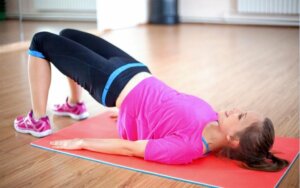Caring for the Pelvic Floor with Kegel Exercises


Written and verified by the psychologist Valeria Sabater
Dr. Arnold H. Kegel, an American gynecologist, developed Kegel exercises in the late 1940s. He wanted to help people attain a sense of well-being, harmony, and internal balance. His work definitely changed the lives of thousands of people. Thus, this system isn’t just another fad but one of the most widespread and accepted practices to tone the pelvic floor.
You’ve probably heard about this type of exercise but few people actually understand its importance until their body changes. It could be due to pregnancy, menopause, incontinence problems, impact sports, or simply aging.
The pelvic floor is sensitive to body alterations. It’s basically a set of muscles and tissues that support the reproductive, digestive, and urinary systems.
Back in the day, you couldn’t talk about the urogenital area, as it was another taboo. Fortunately, people changed and science continued to advance. Currently, Kegel exercises are a strategy in the field of medicine and physical therapy. The goal is to improve quality of life.

The purpose and benefits of Kegel exercises
These exercises became known in the mid-20th century and had a clear purpose: to put an end to urinary incontinence. Thus, many people avoided surgery by strengthening the pubococcygeal muscle, which helps control urine flow, among other aspects.
Similarly, there’s a key aspect that can sometimes lead to error. This is because not all techniques work. In other words, not all physical practices use authentic Kegel exercises. Some of them merely exercise the abdominals and buttocks without realizing that they won’t have any impact on organs such as the bladder, intestines, or reproductive system.
Kegel exercises must work the pelvis, as it’s the center of power, well-being, and internal balance, all capable of generating change. As you can see, caring for and working the pelvic floor can totally transform your life. Here’s why.
The best exercises for before and after pregnancy
Contracting and relaxing the pubococcygeal muscle (pelvic floor muscle) is the best exercise you can do before and after pregnancy. Why? Well, because it’ll keep away hemorrhoids, prevent an episiotomy, and even the risk of prolapse.
Likewise, one of the greatest benefits of Kegels in these cases is to be able to overcome postpartum more quickly.
Reduce the impact of urinary incontinence
As we mentioned above, Kegel developed this set of exercises to reduce the impact of urinary incontinence on people. Have you ever heard someone say “Don’t make me laugh because I’ll pee my pants”?
Well, it could definitely happen to those who haven’t incorporated this set of exercises into their lives.
They’ll make a difference in your sex life
How can Kegel exercises improve your sex life? In many ways, actually. For example, vaginal sensitivity will also be much more intense if you’re pelvic floor muscles are stronger. Thus, you’ll have more pleasant orgasms.
In addition, there’s a great way to do these exercises by using yoni eggs. These are part of ancestral Chinese practices that’ll help increase your sexual power and awaken your sensuality. They’ll become your daily allies, for sure.

Kegel exercises in menopause are a great strategy
The pelvic floor is shaped like a hammock, which is no coincidence. This is because this set of muscles, contained between the pubic bone and the base of the spine, support a large part of human internal organs.
Furthermore, prolapses are common with the arrival of menopause. What this means is that some organs sort of fall down and lean into the external pelvic cavity. Thus, these prolapses lead to urine loss and constipation during menopause.
As you can see, something as simple as practicing Kegel exercises three times a day will prevent and treat many of these problems. It’ll definitely increase your quality of life.
Why not start today? Your body could certainly use it. As you well know, well-being starts on the inside. Thus, be aware of your needs and adopt healthier habits. Begin this transformation today by making Kegel exercises a part of your routine.
Dr. Arnold H. Kegel, an American gynecologist, developed Kegel exercises in the late 1940s. He wanted to help people attain a sense of well-being, harmony, and internal balance. His work definitely changed the lives of thousands of people. Thus, this system isn’t just another fad but one of the most widespread and accepted practices to tone the pelvic floor.
You’ve probably heard about this type of exercise but few people actually understand its importance until their body changes. It could be due to pregnancy, menopause, incontinence problems, impact sports, or simply aging.
The pelvic floor is sensitive to body alterations. It’s basically a set of muscles and tissues that support the reproductive, digestive, and urinary systems.
Back in the day, you couldn’t talk about the urogenital area, as it was another taboo. Fortunately, people changed and science continued to advance. Currently, Kegel exercises are a strategy in the field of medicine and physical therapy. The goal is to improve quality of life.

The purpose and benefits of Kegel exercises
These exercises became known in the mid-20th century and had a clear purpose: to put an end to urinary incontinence. Thus, many people avoided surgery by strengthening the pubococcygeal muscle, which helps control urine flow, among other aspects.
Similarly, there’s a key aspect that can sometimes lead to error. This is because not all techniques work. In other words, not all physical practices use authentic Kegel exercises. Some of them merely exercise the abdominals and buttocks without realizing that they won’t have any impact on organs such as the bladder, intestines, or reproductive system.
Kegel exercises must work the pelvis, as it’s the center of power, well-being, and internal balance, all capable of generating change. As you can see, caring for and working the pelvic floor can totally transform your life. Here’s why.
The best exercises for before and after pregnancy
Contracting and relaxing the pubococcygeal muscle (pelvic floor muscle) is the best exercise you can do before and after pregnancy. Why? Well, because it’ll keep away hemorrhoids, prevent an episiotomy, and even the risk of prolapse.
Likewise, one of the greatest benefits of Kegels in these cases is to be able to overcome postpartum more quickly.
Reduce the impact of urinary incontinence
As we mentioned above, Kegel developed this set of exercises to reduce the impact of urinary incontinence on people. Have you ever heard someone say “Don’t make me laugh because I’ll pee my pants”?
Well, it could definitely happen to those who haven’t incorporated this set of exercises into their lives.
They’ll make a difference in your sex life
How can Kegel exercises improve your sex life? In many ways, actually. For example, vaginal sensitivity will also be much more intense if you’re pelvic floor muscles are stronger. Thus, you’ll have more pleasant orgasms.
In addition, there’s a great way to do these exercises by using yoni eggs. These are part of ancestral Chinese practices that’ll help increase your sexual power and awaken your sensuality. They’ll become your daily allies, for sure.

Kegel exercises in menopause are a great strategy
The pelvic floor is shaped like a hammock, which is no coincidence. This is because this set of muscles, contained between the pubic bone and the base of the spine, support a large part of human internal organs.
Furthermore, prolapses are common with the arrival of menopause. What this means is that some organs sort of fall down and lean into the external pelvic cavity. Thus, these prolapses lead to urine loss and constipation during menopause.
As you can see, something as simple as practicing Kegel exercises three times a day will prevent and treat many of these problems. It’ll definitely increase your quality of life.
Why not start today? Your body could certainly use it. As you well know, well-being starts on the inside. Thus, be aware of your needs and adopt healthier habits. Begin this transformation today by making Kegel exercises a part of your routine.
This text is provided for informational purposes only and does not replace consultation with a professional. If in doubt, consult your specialist.







